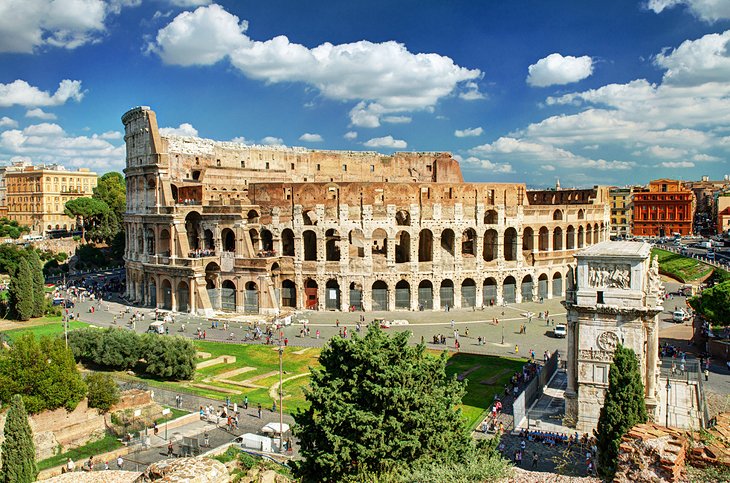Best rated Rome destinations: The name ‘Villa Borghese’ refers to the largest and most beautiful park in Rome. At one time, this estate belonged to the very wealthy cardinal Scipione Borghese, and was built around the villa of the same name. Since 1903, it has been in the possession of the municipality of Rome and serves as a public park. The ‘Galleria Borghese’ can also be found in the park, a museum displaying the large private art collection of Borghese. The gallery contains sculptures and paintings by artists such as Caravaggio, Rubens, Bernini and Leonardo da Vinci. The Piazza del Popolo is a large neo-classical square from the 19th century, originally intended to welcome visitors who entered the city from the north. Noteworthy sights on the square are the two identical churches built across from each other, the city gate ‘Porta del Popolo’, an enormous Egyptian obelisk and the steps that let you climb Pincio Hill for a wonderful view. Read more info on things to do in Rome.
As you might expect for the episcopal church of the Pope, St. John Lateran is one of Rome’s most impressive churches. After centuries of alterations, it still retains its original form from the age of Constantine, when it was built. Its fa?ade, by contrast, is a purely baroque embellishment and a fine example of that period. Along with the mosaics in the apse, be sure to notice the beautiful 16th-century wooden ceiling. If the octagonal baptistery, San Giovanni in Fonte, looks a bit familiar, it’s because it provided the model for later ones throughout Europe. Built by Constantine, it is the world’s oldest Christian baptistery. Across the piazza, in the church of the Scala Santa, is the Holy Staircase, 28 steps believed to have been brought to Rome in the fourth century by St. Helen, from Pilate’s palace in Jerusalem.
Free things to do in Rome : Walk the Ancient Appian Way, The Appian Way (Via Appia Antica) was Europe’s first highway. Built in 312 B.C., the Appian Way connected Rome with Capua running in a straight line for much of the way. The part of the old road close to Rome is part of a nature and archaeological park, the Parco Regionale dell’Appia Antica. Walk on the old road out of Rome on Sunday, when no cars are allowed. There are lots of ancient things to see on the peaceful walk, and the park has detailed routes and maps of the best walking and biking routes. While you are there see the ruins of Roman monuments, two major Christian catacombs, and the Domine Quo Vadis Church. In the nave look for the footprints reputed to be those of Jesus.
Of course, we must highlight the Vatican Museums, one of the most extensive art collections in the world. Raphael, Caravaggio and Leonardo da Vinci are some of the painters present in this exhibition. But the Sistine Chapel is undoubtedly the highlight. This room, where the cardinals hold the Conclave to elect the new Pope, is famous for its impressive ceiling fresco and the mural painting of the Last Judgement, both painted by the legendary Michelangelo in the 16th century. Words cannot explain it, it’s pure beauty! The Pantheon is one of Rome’s best-preserved ancient structures. Originally, the Pantheon was built as a temple dedicated to Roman gods and was later converted to a Christian church. Built almost 2000 years ago, this massive structure is still considered an architectural masterpiece. Perhaps its most astounding element is its crowning dome, which still boasts the title of having the largest unsupported concrete dome on the planet. Discover extra information on lvtsk.com.
Near Campo dei Fiori yet blissfully uncrowded, Palazzo Spada is a striking historic palace built in the 16th century and redesigned by Roman architect Borromini in the 17th century. Inside there’s a rich art collection with Renaissance and Baroque masters, and outside there’s a peaceful courtyard where eight impressive colonnades create a mesmerising optical illusion. The palace itself is exquisitely Baroque, with elegant, perfect symmetry and ornate decorations. Inside, there are walls plastered in frescoes, immaculate stucco work, and grand halls of opulent, gilded marble. Palazzo Spada houses an incredible art collection, with paintings, sculptures, and decorative arts by artists including Titian and Caravaggio. Don’t miss the Borromini Perspective Gallery, a masterclass in optical illusion where a corridor appears to be much longer than it actually is.
Castel Sant’Angelo – Castel Sant’Angelo was built to be a mausoleum for the Emperor Hadrian and his family. Built in 123 BC, it later was turned into a fortress and castle by the popes. It was once Rome’s tallest building. The ashes of other emperors were buried there, but scattered when the Visigoths invaded in 410. It also served as a prison, but today the castel is a museum. Among the most well known sights in Rome, film buffs will recognize it as a setting from “Angels and Demons”.
Piazza Venezia , Located at the heart of Rome, Piazza Venezia is a large hub and thoroughfare built during the 19th and 20th centuries, along with the enormous Altare della Patria or Monument, dedicated to honor Vittorio Emanuele II, who was the first king to serve under a unified Italy in 1861 and known as the “Father of the Fatherland”. Via del Corso and Via dei Fori Imperiali are two important streets that intersect in Piazza Venezia.
